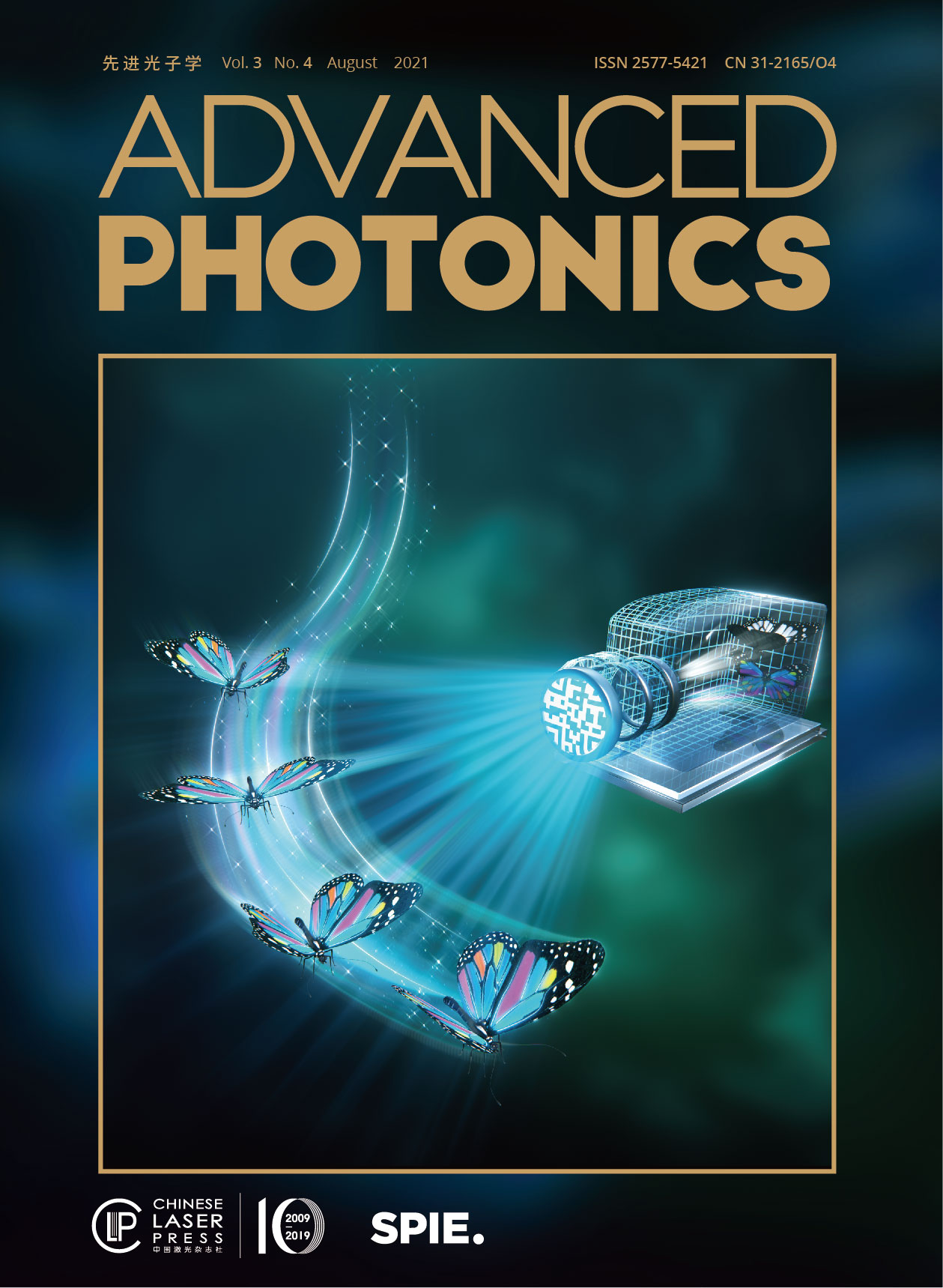 View fulltext
View fulltext
The image on the cover for Advanced Photonics Volume 3 Issue 4 depicts a fast-flying butterfly with colorful information on its wings – this dynamic scene is captured by a multidimensional computational camera with super high temporal, volumetric, and spectral resolution. The camera is built based on compressed ultrafast imaging technology, which can simultaneously capture 5D information in a single snapshot by combining compressive sensing with temporal-to-spatial and spectral-to-spatial conversion techniques.
Optical imaging has served as a primary method to collect information about biosystems across scales—from functionalities of tissues to morphological structures of cells and even at biomolecular levels. However, to adequately characterize a complex biosystem, an imaging system with a number of resolvable points, referred to as a space-bandwidth product (SBP), in excess of one billion is typically needed. Since a gigapixel-scale far exceeds the capacity of current optical imagers, compromises must be made to obtain either a low spatial resolution or a narrow field-of-view (FOV). The problem originates from constituent refractive optics—the larger the aperture, the more challenging the correction of lens aberrations. Therefore, it is impractical for a conventional optical imaging system to achieve an SBP over hundreds of millions. To address this unmet need, a variety of high-SBP imagers have emerged over the past decade, enabling an unprecedented resolution and FOV beyond the limit of conventional optics. We provide a comprehensive survey of high-SBP imaging techniques, exploring their underlying principles and applications in bioimaging.
Dynamic plasmonics with the real-time active control capability of plasmonic resonances attracts much interest in the communities of physics, chemistry, and material science. Among versatile reconfigurable strategies for dynamic plasmonics, electrochemically driven strategies have garnered most of the attention. We summarize three primary strategies to enable electrochemically dynamic plasmonics, including structural transformation, carrier-density modulation, and electrochemically active surrounding-media manipulation. The reconfigurable microstructures, optical properties, and underlying physical mechanisms are discussed in detail. We also summarize the most promising applications of dynamic plasmonics, including smart windows, structural color displays, and chemical sensors. We suggest more research efforts toward the widespread applications of dynamic plasmonics.
In ultrafast optical imaging, it is critical to obtain the spatial structure, temporal evolution, and spectral composition of the object with snapshots in order to better observe and understand unrepeatable or irreversible dynamic scenes. However, so far, there are no ultrafast optical imaging techniques that can simultaneously capture the spatial–temporal–spectral five-dimensional (5D) information of dynamic scenes. To break the limitation of the existing techniques in imaging dimensions, we develop a spectral-volumetric compressed ultrafast photography (SV-CUP) technique. In our SV-CUP, the spatial resolutions in the x, y and z directions are, respectively, 0.39, 0.35, and 3 mm with an 8.8 mm × 6.3 mm field of view, the temporal frame interval is 2 ps, and the spectral frame interval is 1.72 nm. To demonstrate the excellent performance of our SV-CUP in spatial–temporal–spectral 5D imaging, we successfully measure the spectrally resolved photoluminescent dynamics of a 3D mannequin coated with CdSe quantum dots. Our SV-CUP brings unprecedented detection capabilities to dynamic scenes, which has important application prospects in fundamental research and applied science.
Optical superoscillation refers to an intriguing phenomenon of a wave packet that can oscillate locally faster than its highest Fourier component, which potentially produces an extremely localized wave in the far field. It provides an alternative way to overcome the diffraction limit, hence improving the resolution of an optical microscopy system. However, the optical superoscillatory waves are inevitably accompanied by strong side lobes, which limits their fields of view and, hence, potential applications. Here, we report both experimentally and theoretically a new superoscillatory wave form, which not only produces significant feature size down to deep subwavelength, but also completely eliminates side lobes in a particular dimension. We demonstrate a new mechanism for achieving such a wave form based on a pair of moonlike sharp-edge apertures. The resultant superoscillatory wave exhibits Bessel-like forms, hence allowing long-distance propagation of subwavelength structures. The result facilitates the study of optical superoscillation and on a fundamental level eliminates the compromise between the superoscillatory feature size and the field of view.
As a new-generation light source, free-electron lasers (FELs) provide high-brightness x-ray pulses at the angstrom-femtosecond space and time scales. The fundamental physics behind the FEL is the interaction between an electromagnetic wave and a relativistic electron beam in an undulator, which consists of hundreds or thousands of dipole magnets with an alternating magnetic field. We report the first observation of the laser–beam interaction in a pure dipole magnet in which the electron beam energy modulation with a 40-keV amplitude and a 266-nm period is measured. We demonstrate that such an energy modulation can be used to launch a seeded FEL, that is, lasing at the sixth harmonic of the seed laser in a high-gain harmonic generation scheme. The results reveal the most basic process of the FEL lasing and open up a new direction for the study and exploitation of laser–beam interactions.













